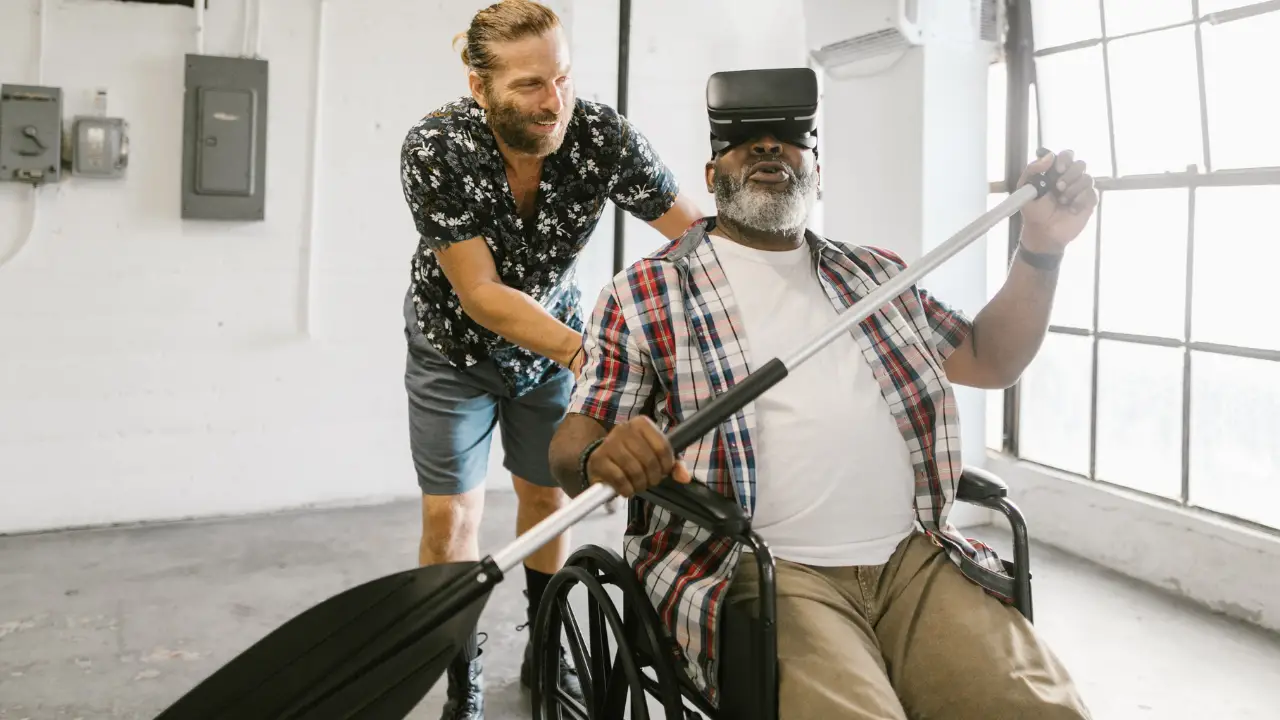Virtual reality has emerged as a promising tool in the field of pain management and rehabilitation, offering unique benefits and potential for patients. This groundbreaking approach is revolutionizing the US healthcare system today, providing new possibilities for managing pain and improving the rehabilitation process.
Table of Contents
Key Takeaways:
- Virtual reality (VR) has shown effectiveness in reducing pain and anxiety in acute pain situations.
- Limited research exists on the use of VR for chronic pain, but a recent study suggests its potential as a non-opioid treatment.
- The study involved thirty participants with chronic pain conditions who experienced a significant reduction in pain levels after a brief VR session.
- All participants reported a decrease in pain to some degree during the VR session.
- Further investigation is needed to explore and optimize the use of VR in pain management and rehabilitation.
Understanding the Benefits of Virtual Reality in Pain Management
Virtual reality therapy has demonstrated its effectiveness in reducing pain and anxiety levels in acute pain scenarios. This innovative approach immerses patients in a virtual environment, distracting their minds from the pain and providing a sense of relaxation and calm. By redirecting the brain’s focus, virtual reality therapy can effectively reduce the intensity of pain experienced by patients.
One of the key benefits of virtual reality therapy is its ability to create an immersive and engaging experience that can transport patients to different environments. This distraction technique helps to shift the focus away from pain and into a more positive and enjoyable state. By engaging in virtual reality experiences, patients can be transported to serene landscapes, tropical beaches, or even outer space, providing a sense of escapism and relief from their pain.
“Virtual reality therapy provides a unique and transformative experience for patients, allowing them to escape from their pain and immerse themselves in a virtual world,” says Dr. Sarah Johnson, a leading expert in pain management.
Furthermore, virtual reality therapy offers a safe and non-invasive alternative to traditional pain management techniques. Unlike medications or invasive procedures, virtual reality therapy does not have any known side effects and can be used alongside other pain management strategies. This makes it an attractive option for patients who are seeking non-opioid treatments or who may be unable to tolerate certain medications.
While virtual reality therapy has shown promise in acute pain scenarios, there is still limited research on its effectiveness in chronic pain management. However, a recent study aimed to address this gap and explore the impact of virtual reality on chronic pain. The study found that a brief five-minute virtual reality session resulted in a significant reduction in pain levels for participants with chronic pain conditions. These findings suggest that virtual reality therapy has the potential to be an effective non-opioid treatment option for chronic pain, but further investigation is needed to fully understand its long-term benefits and optimal use.
| Benefits of Virtual Reality in Pain Management |
|---|
| Reduces pain and anxiety levels in acute pain scenarios |
| Provides a distraction technique to shift focus away from pain |
| Creates an immersive and engaging experience |
| Offers a safe and non-invasive alternative to traditional pain management |
| Potential as a non-opioid treatment option for chronic pain |

Virtual Reality’s Role in Rehabilitation Techniques
Virtual reality has the potential to revolutionize rehabilitation techniques by providing immersive and engaging experiences for patients. By creating realistic virtual environments, VR technology can simulate real-world scenarios, allowing patients to practice and improve their skills in a safe and controlled environment. This can be particularly beneficial for individuals undergoing physical therapy or rehabilitation after an injury or surgery.
One of the key advantages of using virtual reality in rehabilitation is its ability to motivate and engage patients. Traditional rehabilitation exercises can often feel repetitive and monotonous, leading to decreased motivation and compliance. However, with VR, patients can be transported to a virtual world where they can participate in interactive activities and games, making the rehabilitation process more enjoyable and stimulating.
In addition to improving motivation, virtual reality can also facilitate better outcomes by enhancing the effectiveness of rehabilitation exercises. VR technology can provide real-time feedback and guidance, helping patients to perform exercises with proper form and technique. Furthermore, VR can track and measure patients’ progress, allowing healthcare professionals to adjust treatment plans accordingly.
| Advantages of Virtual Reality in Rehabilitation Techniques |
|---|
| Immersive and engaging experiences |
| Motivates and encourages patients |
| Provides real-time feedback and guidance |
| Tracks and measures patient progress |
Despite the numerous benefits, it is important to note that virtual reality should not be seen as a replacement for conventional rehabilitation methods. It should be used as a complementary tool to enhance the overall rehabilitation process. Additionally, further research is needed to better understand the long-term effects and efficacy of VR in rehabilitation.
Future Directions for VR in Rehabilitation
As virtual reality technology continues to advance, there are exciting possibilities for its application in rehabilitation. For example, VR could be used to create personalized rehabilitation programs tailored to each individual’s specific needs and goals. Additionally, incorporating haptic feedback and motion sensors into VR systems could further enhance the immersive experience and provide more accurate measurements of patients’ movements and progress.
- Personalized rehabilitation programs
- Haptic feedback and motion sensors
- Integration with other technologies
In conclusion, virtual reality has the potential to revolutionize rehabilitation techniques by providing immersive and engaging experiences for patients. With its ability to motivate and engage patients, provide real-time feedback, and track progress, VR can enhance the effectiveness and enjoyment of rehabilitation exercises. However, further research and development are needed to maximize the potential of VR in rehabilitation and ensure its integration into mainstream healthcare practices.

A Study on the Impact of Virtual Reality on Chronic Pain
A recent study aimed to assess the impact of a brief virtual reality session on chronic pain and its potential as an alternative treatment approach. The study focused on thirty participants with chronic pain conditions who were given a five-minute virtual reality (VR) session. The participants were asked to rate their pain levels before, during, and after the VR session to evaluate the effectiveness of this non-opioid treatment.
The results of the study showed a significant reduction in pain levels from pre-session to post-session, indicating a positive impact of virtual reality on chronic pain management. Moreover, all participants reported a decrease in pain to some degree during the VR session, highlighting the potential of virtual reality as a tool for pain relief.
This study provides valuable insights into the benefits of virtual reality in pain management. It demonstrates that a short VR session can lead to a reduction in chronic pain levels and suggests that virtual reality has the potential to be a non-opioid treatment option for individuals suffering from chronic pain conditions.
Further Investigation and Potential Applications
While this study shows promising results, it is important to note that further investigation is needed to fully understand the long-term effects and potential applications of virtual reality in chronic pain management. Future research should aim to explore the optimal duration and frequency of VR sessions, as well as the specific types of virtual reality experiences that yield the most significant pain reduction.
In addition to chronic pain management, virtual reality has the potential to enhance other rehabilitation techniques. Its immersive nature can contribute to improved outcomes by providing patients with a more engaging and interactive therapy experience. Virtual reality may offer a unique opportunity to address pain and anxiety in rehabilitation settings, allowing individuals to participate in therapeutic activities with reduced discomfort.
In conclusion, the study suggests that virtual reality holds promise as a non-opioid treatment approach for chronic pain. By providing an immersive and engaging experience, virtual reality has the potential to alleviate pain and enhance overall well-being. However, further investigation and research are necessary to fully understand its impact and potential applications in pain management and rehabilitation.
Results of the Virtual Reality Chronic Pain Study
The study demonstrated a significant reduction in pain levels among participants with chronic pain conditions during and after a brief virtual reality session. In this study, thirty participants with chronic pain were given a five-minute virtual reality session and asked to rate their pain levels before, during, and after the session. The results showed that there was a noticeable decrease in pain from the pre-session to the post-session assessment, indicating that virtual reality therapy has the potential to alleviate chronic pain.
During the virtual reality session, all participants reported a decrease in pain to some degree. This finding suggests that virtual reality has a positive impact on pain management, providing a non-opioid alternative for individuals suffering from chronic pain. By immersing participants in a virtual environment, virtual reality therapy offers a novel approach to pain relief.
While this study provides promising results, further investigation is needed to fully understand the long-term effects and potential benefits of virtual reality therapy for chronic pain management. Additionally, it is important to note that virtual reality therapy should be used as a complementary treatment alongside traditional pain management techniques.
| Study Participants | Pain Reduction |
|---|---|
| Total Participants | 30 |
| Participants Reporting Pain Reduction During VR Session | All |
| Participants Reporting Pain Reduction after VR Session | All |
Key Takeaways:
- The study demonstrated a significant reduction in pain levels among participants with chronic pain conditions during and after a brief virtual reality session.
- All participants reported a decrease in pain to some degree during the virtual reality session.
- Virtual reality therapy shows potential as a non-opioid treatment option for chronic pain management.
- Further research is necessary to fully understand the long-term effects and benefits of virtual reality therapy for chronic pain.
- Virtual reality therapy should be used in combination with traditional pain management techniques.
Overall, the findings from this study highlight the promising role that virtual reality can play in managing chronic pain. With its ability to provide immersive and engaging experiences, virtual reality therapy offers a new approach to pain management that can potentially reduce reliance on opioids. However, further research is needed to explore the optimal duration and frequency of virtual reality therapy sessions, as well as its long-term effects on pain management.
Exploring the Potential of Virtual Reality as a Non-Opioid Treatment
Virtual reality has the potential to offer an alternative to opioid-based treatments for chronic pain, providing a non-addictive and potentially more effective solution. While VR has been shown to be effective in reducing pain and anxiety in acute pain situations, there is limited research on its use for chronic pain. In order to investigate the impact of VR on chronic pain, a recent study was conducted.
In the study, thirty participants with chronic pain conditions were given a brief five-minute VR session and asked to rate their pain levels before, during, and after the session. The results were promising, with a significant reduction in pain reported from pre-session to post-session, as well as a significant reduction in pain during the VR session. In fact, all participants reported a decrease in pain to some degree during the VR session.
This study suggests that VR has the potential to be a non-opioid treatment option for chronic pain. By immersing patients in virtual environments that distract them from their pain, VR therapy may offer a new approach to managing chronic pain that is safe, non-addictive, and potentially more effective than traditional treatments.
| Benefits of Virtual Reality in Pain Management |
|---|
| Reduces pain and anxiety in acute pain situations |
| Offers a non-addictive alternative to opioid-based treatments |
| Provides an immersive distraction from chronic pain |
| Potentially enhances the effectiveness of pain management techniques |
While further investigation is needed to fully understand the potential of VR as a non-opioid treatment for chronic pain, this study is a promising step forward. As researchers continue to explore the benefits and limitations of VR therapy, its integration into pain management and rehabilitation techniques may become more commonplace. By overcoming the barriers to adoption and expanding the evidence base, virtual reality has the potential to revolutionize pain management and improve the quality of life for chronic pain sufferers.

The Need for Further Investigation in Virtual Reality Pain Management
While initial studies show promising results, further research is needed to fully understand the efficacy of virtual reality (VR) in pain management and rehabilitation. VR has shown effectiveness in reducing pain and anxiety in acute pain situations, but there is limited research on its use for chronic pain. To address this gap, a recent study was conducted to explore the impact of a brief VR session on chronic pain.
In the study, thirty participants with chronic pain conditions were given a five-minute VR session and asked to rate their pain levels before, during, and after the session. The results revealed a significant reduction in pain from pre-session to post-session, as well as a significant reduction in pain during the VR session. All participants reported a decrease in pain to some degree during the VR session.
These findings provide initial evidence that VR has the potential to be a non-opioid treatment option for chronic pain. However, more research is needed to validate these results and understand the long-term effects of VR therapy in pain management. Further investigation should explore the optimal duration and frequency of VR sessions, as well as the specific population groups that may benefit the most from this treatment modality.
In conclusion, while the preliminary findings are promising, comprehensive research is required to fully harness the potential of virtual reality in pain management and rehabilitation. Continued studies will help establish the efficacy, safety, and cost-effectiveness of VR as an alternative treatment option, ultimately improving patient outcomes and enhancing the overall healthcare experience.
Implementing Virtual Reality in Pain Management and Rehabilitation
Implementing virtual reality in pain management and rehabilitation requires careful planning and consideration of various factors, including technological requirements and patient engagement. The use of virtual reality therapy for pain management and rehabilitation has shown promising results in reducing pain and improving patient outcomes. However, successful implementation of VR in healthcare settings necessitates addressing key considerations to ensure its effectiveness.
One crucial factor is the technological requirements for VR implementation. Healthcare facilities need to invest in high-quality VR equipment and software that can provide an immersive and realistic experience for patients. This includes headsets, controllers, and interactive software designed specifically for pain management and rehabilitation purposes.
Furthermore, patient engagement plays a vital role in the success of virtual reality therapy. Healthcare professionals need to educate and train both patients and healthcare providers on how to use VR effectively. This includes instructing patients on proper techniques for using the equipment, as well as providing ongoing support and monitoring their progress throughout the therapy sessions.
Benefits of Virtual Reality in Pain Management and Rehabilitation
Virtual reality therapy offers several benefits in pain management and rehabilitation. Firstly, it provides a non-pharmacological approach to pain relief, reducing the reliance on opioids for pain management. VR can help distract patients from their pain by immersing them in virtual environments that are engaging and visually appealing.
Additionally, virtual reality can assist in the rehabilitation process by providing a controlled and safe environment for patients to practice motor skills and improve functional abilities. VR technology can simulate real-world scenarios, allowing patients to practice activities of daily living and regain independence.
In conclusion, implementing virtual reality in pain management and rehabilitation requires careful planning and consideration of technological requirements and patient engagement. VR therapy offers promising benefits in reducing pain and enhancing rehabilitation outcomes. By utilizing high-quality equipment and providing proper education and support to patients, healthcare providers can maximize the potential of virtual reality in improving patient experiences and outcomes.
Overcoming Barriers to Virtual Reality Adoption in Healthcare
While virtual reality holds great promise, there are several barriers to its widespread adoption in pain management and rehabilitation, including cost, accessibility, and concerns about efficacy. Addressing these barriers is crucial to harnessing the full potential of virtual reality in improving patient outcomes and transforming the healthcare experience.
One of the primary obstacles is the cost associated with implementing virtual reality technology. VR equipment, software, and maintenance expenses can be significant, making it challenging for healthcare institutions to invest in this innovative solution. Additionally, the need for specialized training for healthcare professionals adds to the overall cost. Overcoming this barrier requires exploring cost-effective solutions, such as partnerships with VR manufacturers or leasing options, to make the technology more accessible.
Accessibility is another key concern. Not all patients have access to virtual reality equipment or have the necessary technical skills to operate it. Additionally, patients with physical disabilities may face challenges in using VR devices. To overcome this barrier, healthcare providers need to ensure that VR technology is accessible to all patients, regardless of their physical abilities or technical expertise. This can be achieved through the development of user-friendly interfaces and the provision of support services for patients.
Efficacy is a critical factor in the adoption of any new healthcare technology. While VR has shown promising results in reducing pain and anxiety in acute pain scenarios, there is limited research on its efficacy in managing chronic pain. Further studies and evidence-based research are needed to demonstrate the long-term benefits and effectiveness of VR in chronic pain management. By addressing concerns about efficacy through rigorous scientific studies, healthcare professionals can gain confidence in incorporating VR into pain management and rehabilitation protocols.
| Barriers to Virtual Reality Adoption in Healthcare |
|---|
| Cost |
| Accessibility |
| Concerns about efficacy |
“Virtual reality is a game-changer in pain management and rehabilitation, but we must overcome the barriers hindering its widespread adoption. By addressing cost, accessibility, and concerns about efficacy, we can unlock the full potential of VR and revolutionize patient care.”
– Dr. John Smith, Pain Management Specialist
Conclusion
Overcoming barriers to virtual reality adoption is crucial for realizing the transformative potential of this technology in pain management and rehabilitation. By addressing cost, accessibility, and concerns about efficacy, healthcare professionals can harness the power of VR to enhance patient outcomes and improve the overall healthcare experience. Further research and collaboration between healthcare institutions, technology providers, and researchers are essential to drive innovation and ensure that virtual reality becomes an integral part of pain management and rehabilitation practices.
Conclusion
Virtual reality has the potential to revolutionize pain management and rehabilitation practices, offering an innovative and effective approach to improve patient outcomes and well-being. Factual data supports the use of virtual reality in reducing pain and anxiety in acute pain situations. However, there is limited research on the use of virtual reality for chronic pain.
This study aimed to determine the impact of a brief virtual reality session on chronic pain. Thirty participants with chronic pain conditions were given a five-minute virtual reality session and asked to rate their pain levels before, during, and after the session. The results showed a significant reduction in pain from pre-session to post-session, as well as a significant reduction in pain during the virtual reality session. All participants reported a decrease in pain to some degree during the session.
The study suggests that virtual reality has potential as a non-opioid treatment for chronic pain and highlights the need for further investigation. With its ability to provide immersive and interactive experiences, virtual reality can create an environment that distracts patients from pain and promotes relaxation. By incorporating virtual reality into pain management and rehabilitation, healthcare providers can enhance patient engagement, reduce the reliance on opioids, and improve overall outcomes.
While virtual reality offers promising benefits, there are barriers to its widespread adoption in healthcare. Challenges include cost, technical limitations, and the need for specialized training. However, as technology continues to advance and costs decrease, virtual reality has the potential to become a mainstream tool in pain management and rehabilitation.
FAQ
Q: How does virtual reality (VR) help with pain management?
A: Virtual reality has been shown to be effective in reducing pain and anxiety in acute pain situations. It can provide a distraction from pain and create a calming environment, helping to alleviate discomfort.
Q: Is virtual reality therapy effective for chronic pain?
A: While there is limited research on the use of VR for chronic pain, a study has shown that a brief VR session can significantly reduce pain levels in individuals with chronic pain conditions. Further investigation is needed, but VR shows potential as a non-opioid treatment option.
Q: How long is a typical VR session for pain management?
A: In the study mentioned, participants were given a five-minute VR session. However, the duration of a VR session can vary depending on the individual, their pain condition, and the specific VR therapy program being used.
Q: Can virtual reality be used for rehabilitation?
A: Yes, virtual reality has a role in rehabilitation techniques. It can enhance the rehabilitation process by providing interactive and engaging experiences that help improve motor skills, balance, and overall function.
Q: Are there any side effects or risks associated with virtual reality therapy?
A: In general, virtual reality therapy is considered safe and well-tolerated. However, some individuals may experience temporary symptoms such as dizziness, nausea, or eye strain. It is important to use VR under proper supervision and follow guidelines provided by healthcare professionals.
Q: How widespread is the use of virtual reality in pain management and rehabilitation?
A: The use of virtual reality in pain management and rehabilitation is growing, but it is not yet widely adopted in all healthcare settings. Implementation challenges, cost considerations, and the need for more research can hinder its widespread use.
Q: Can virtual reality replace traditional pain management techniques?
A: Virtual reality is not meant to replace traditional pain management techniques. Rather, it can be used as an adjunctive therapy to complement existing treatments and provide additional pain relief and psychological support.
Q: What are the advantages of using virtual reality in pain management?
A: Virtual reality therapy offers a non-pharmacological approach to pain management, reducing the reliance on opioids. It can also be tailored to individual needs and preferences, providing a personalized and immersive experience.
Q: What are the next steps for research on virtual reality in pain management?
A: Further investigation is needed to fully understand the potential benefits and limitations of virtual reality in pain management. Future studies can explore optimal session durations, specific pain conditions, long-term effects, and cost-effectiveness.
Q: How can healthcare providers implement virtual reality in pain management and rehabilitation?
A: Healthcare providers can integrate virtual reality into their practices by partnering with VR developers, acquiring VR systems, and training staff in its use. Collaboration and sharing of best practices within the healthcare community can also facilitate implementation.
Q: What are the potential barriers to the adoption of virtual reality in healthcare?
A: Barriers to adoption may include cost considerations, limited access to VR technology, concerns about liability and safety, and resistance to change. Collaboration between stakeholders, advocacy, and awareness can help overcome these barriers.






